Assessing the Impact of Park Renovations on Cultural Ecosystem Services
Abstract
1. Introduction
2. Materials and Methods
2.1. Study Area
2.2. Data Collection
2.3. Data Analysis
| Cultural Ecosystem Services | Definition | Mapping Questions |
|---|---|---|
| Recreation and ecotourism | Characteristics of living systems that enable activities promoting health, recuperation or enjoyment through active or immersive interactions. | Where do you perform activities (i.e., do sports, walking) and relaxing? [42,46] |
| Aesthetic values | Characteristics of living systems that enable aesthetic experience. | Where were you touched by the beauty of the park? [42] |
| Educational values | Characteristics of living systems that enable education, training, scientific investigation or the creation of traditional ecological knowledge. | Where do you feel that you learn a lot? [42] |
| Religious and spiritual values | Elements of living systems that have spiritual, sacred or religious meaning. | Where do you gain experience about sacred or religious elements? [17,42,47] |
| Cultural heritage values | Characteristics or features of living systems that have an existence value, historical value, or that are resonant in terms of culture or heritage. | Where do you feel the historical culture? [48] |
| Inspiration | Ecosystems provide rich sources of inspiration for art, folklore, national symbols, architecture, and advertising. | Where inspires you? [17] |
| Social relations | Ecosystems influence the types of social relations that are established in particular cultures. | Where do you feel a strengthened bond with others? [42] |
| Sense of place | The collection that people feel with recognized features of the environment, including aspects of ecosystem. | Where do you feel a sense of belonging or have a lot of memorable experiences? [46,49] |
3. Results
3.1. The Distribution of CES under the Park Renovation
3.2. Specific Park Renovations Associated with CES
4. Discussion
4.1. Park Renovation Influence on the CES Distribution
4.2. Integrating CES Evaluation to Support Park Design and Management
4.3. Methodology Considerations
5. Conclusions
Author Contributions
Funding
Informed Consent Statement
Data Availability Statement
Acknowledgments
Conflicts of Interest
Appendix A. Supplementary Data
| Cultural Ecosystem Services | Questions |
|---|---|
| Recreation and ecotourism | Where in this park do you perform activities (i.e., do sports, walking) and relaxing before the renovation? And after the renovation? Please state reasons? |
| Aesthetic values | Where in this park were you touched by the beauty before the renovation? And after the renovation? Please state reasons? |
| Education values | Where in this park do you feel that you learned a lot before the renovation? And after the renovation? Please state reasons? |
| Religious and spiritual values | Where in this park do you gain experience about sacred or religious elements before the renovation? And after the renovation? Please state reasons? |
| Cultural heritage values | Where in this park do you feel the historical culture before the renovation? And after the renovation? Please state reasons? |
| Inspiration | Where in this park inspires you before the renovation? And after the renovation? Please state reasons? |
| Social relations | Where in this park do you feel a strengthened bond with others before the renovation? And after the renovation? Please state reasons? |
| Sense of place | Where in this park do you feel a sense of belonging or have a lot of memorable experiences before the renovation? And after the renovation? Please state reasons? |
| Questions | Response |
|---|---|
| You are | Female Male |
| Your age is | 12–18 19–29 30–39 40–64 ≥65 |
| What is your highest educational qualification? | <Bachelor’s degree Bachelor degree Master degree ≥PhD |
| What is your occupation? | Employed Retired Housewife/-husband Student Unemployed Others |
| What is your income? | None 0–2999 RMB 3000–4999 RMB 5000–9999 RMB ≥10,000 RMB |
| How often do you visit green space in summer time? | Everyday 4–6 times/week 2–3 times/week Once a week 1–3 times/month |
| How often do you visit green space in winter time? | Everyday 4–6 times/week 2–3 times/week Once a week 1–3 times/month |
| Category | Responses | Interviewees (n) | Percentage |
|---|---|---|---|
| Gender | Female | 31 | 46% |
| Male | 37 | 54% | |
| Age | 12–18 | 6 | 9% |
| 19–29 | 9 | 13% | |
| 30–39 | 24 | 35% | |
| 40–64 | 19 | 28% | |
| ≥65 | 10 | 15% | |
| Education | <Bachelor’s degree | 37 | 54% |
| Bachelor degree | 20 | 30% | |
| Master degree | 9 | 13% | |
| ≥PhD | 2 | 3% | |
| Occupation | Employed | 27 | 40% |
| Retired | 11 | 16% | |
| Housewife/-husband | 8 | 12% | |
| Student | 9 | 13% | |
| Unemployed | 2 | 3% | |
| Others | 11 | 16% | |
| Income | None | 18 | 27% |
| 0–2999 RMB | 9 | 13% | |
| 3000–4999 RMB | 17 | 25% | |
| 5000–9999 RMB | 19 | 30% | |
| ≥10,000 RMB | 5 | 7% | |
| Frequency visiting: summer time | Everyday | 6 | 9% |
| 4–6 times/week | 13 | 19% | |
| 2–3 times/week | 7 | 10% | |
| Once a week | 14 | 21% | |
| 1–3 times/month | 28 | 41% | |
| Frequency visiting: Winter time | Everyday | 2 | 3% |
| 4–6 times/week; | 11 | 16% | |
| 2–3 times/week | 8 | 12% | |
| Once a week | 13 | 19% | |
| 1–3 times/month | 34 | 50% |
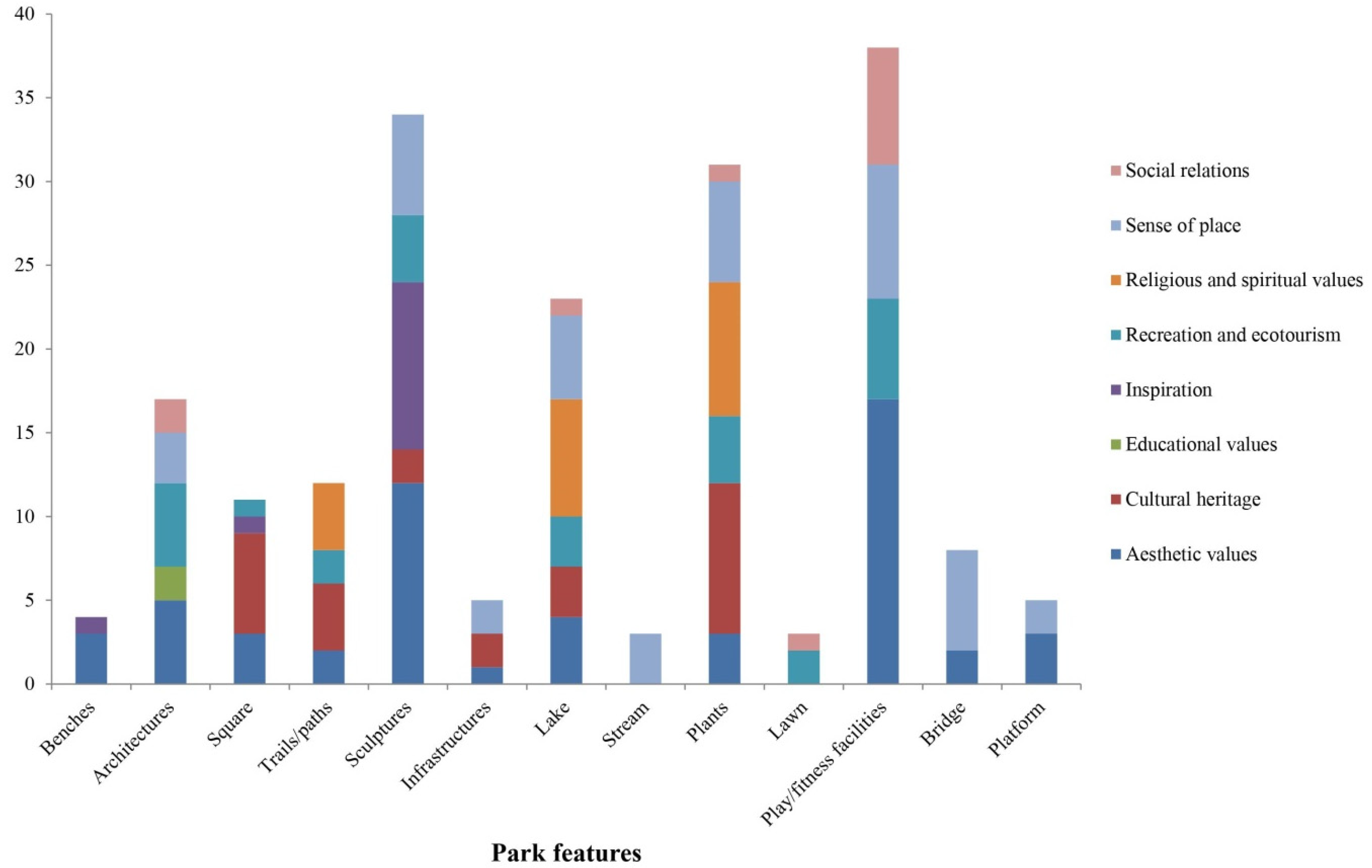
References
- Millennium Ecosystem Assessment (MEA). Ecosystems and Human Well-Being: Synthesis; Island Press: Washington, DC, USA, 2005. [Google Scholar]
- Van Riper, C.J.; Kyle, G. Capturing multiple values of ecosystem services shaped by environmental worldviews: A spatial analysis. J. Environ. Manag. 2014, 145, 374–384. [Google Scholar] [CrossRef] [PubMed]
- Orenstein, D. More than Language Is Needed in Valuing Ecosystem Services. BioScience 2013, 63, 913. [Google Scholar] [CrossRef][Green Version]
- Opdam, P.; Albert, C.; Fürst, C.; Grêt-Regamey, A.; Kleemann, J.; Parker, D.; La Rosa, D.; Schmidt, K.; Villamor, G.B.; Walz, A. Ecosystem services for connecting actors—Lessons from a symposium. Chang. Adapt. Socio-Ecol. Syst. 2015, 2, 1–7. [Google Scholar] [CrossRef]
- Plieninger, T.; Dijks, S.; Oteros-Rozas, E.; Bieling, C. Assessing, mapping, and quantifying cultural ecosystem services at community level. Land Use Policy 2013, 33, 118–129. [Google Scholar] [CrossRef]
- Roy, M.; Shemdoe, R.; Hulme, D.; Mwageni, N.; Gough, A. Climate change and declining levels of green structures: Life in informal settlements of Dar es Salaam, Tanzania. Landsc. Urban Plan. 2018, 180, 282–293. [Google Scholar] [CrossRef]
- Beichler, S.A.; Bastian, O.; Haase, D.; Heiland, S.; Kabisch, N.; Müller, F. Does the Ecosystem Service Concept Reach its Limits in Urban Environments? Landsc. Online 2017, 51, 1–22. [Google Scholar] [CrossRef]
- Rall, E.; Bieling, C.; Zytynska, S.; Haase, D. Exploring city-wide patterns of cultural ecosystem service perceptions and use. Ecol. Indic. 2017, 77, 80–95. [Google Scholar] [CrossRef]
- Wendel, H.E.W.; Zarger, R.K.; Mihelcic, J.R. Accessibility and usability: Green space preferences, perceptions, and barriers in a rapidly urbanizing city in Latin America. Landsc. Urban Plan. 2012, 107, 272–282. [Google Scholar] [CrossRef]
- Raudsepp-Hearne, C.; Peterson, G.D.; Bennett, E.M. Ecosystem service bundles for analyzing tradeoffs in diverse landscapes. Proc. Natl. Acad. Sci. USA 2010, 107, 5242–5247. [Google Scholar] [CrossRef]
- Horcea-Milcu, A.-I.; Hanspach, J.; Abson, D.; Fischer, J. Cultural Ecosystem Services: A Literature Review and Prospects for Future Research. Ecol. Soc. 2013, 18, 3. [Google Scholar] [CrossRef]
- Buchel, S.; Frantzeskaki, N. Citizens’ voice: A case study about perceived ecosystem services by urban park users in Rotterdam, the Netherlands. Ecosyst. Serv. 2015, 12, 169–177. [Google Scholar] [CrossRef]
- Voigt, A.; Wurster, D. Does diversity matter? The experience of urban nature’s diversity: Case study and cultural concept. Ecosyst. Serv. 2015, 12, 200–208. [Google Scholar] [CrossRef]
- Campbell, L.K.; Svendsen, E.S.; Sonti, N.F.; Johnson, M.L. A social assessment of urban parkland: Analyzing park use and meaning to inform management and resilience planning. Environ. Sci. Policy 2016, 62, 34–44. [Google Scholar] [CrossRef]
- Chan, K.M.A.; Guerry, A.D.; Balvanera, P.; Klain, S.; Satterfield, T.; Basurto, X.; Bostrom, A.; Chuenpagdee, R.; Gould, R.; Halpern, B.S.; et al. Where are Cultural and Social in Ecosystem Services? A Framework for Constructive Engagement. BioScience 2012, 62, 744–756. [Google Scholar] [CrossRef]
- Cheng, X.; Van Damme, S.; Li, L.; Uyttenhove, P. Evaluation of cultural ecosystem services: A review of methods. Ecosyst. Serv. 2019, 37, 100925. [Google Scholar] [CrossRef]
- Chan, K.; Satterfield, T.; Goldstein, J. Rethinking ecosystem services to better address and navigate cultural values. Ecol. Econ. 2012, 74, 8–18. [Google Scholar] [CrossRef]
- Droomers, M.; Jongeneel-Grimen, B.; Kramer, D.; de Vries, S.; Kremers, S.; Bruggink, J.-W.; van Oers, H.; Kunst, A.E.; Stronks, K. The impact of intervening in green space in Dutch deprived neighbourhoods on physical activity and general health: Results from the quasi-experimental URBAN40 study. J. Epidemiol. Community Health 2016, 70, 147–154. [Google Scholar] [CrossRef]
- Yang, B.; Li, S.; Binder, C. A research frontier in landscape architecture: Landscape performance and assessment of social benefits. Landsc. Res. 2015, 41, 314–329. [Google Scholar] [CrossRef]
- Martin, C.L.; Momtaz, S.; Gaston, T.; Moltschaniwskyj, N. A systematic quantitative review of coastal and marine cultural ecosystem services: Current status and future research. Mar. Policy 2016, 74, 25–32. [Google Scholar] [CrossRef]
- Veitch, J.; Ball, K.; Crawford, D.; Abbott, G.R.; Salmon, J. Park improvements and park activity: A natural experiment. Am. J. Prev. Med. 2012, 42, 616–619. [Google Scholar] [CrossRef]
- Vert, C.; Carrasco-Turigas, G.; Zijlema, W.; Espinosa, A.; Cano-Riu, L.; Elliott, L.; Litt, J.; Nieuwenhuijsen, M.; Gascon, M. Impact of a riverside accessibility intervention on use, physical activity, and wellbeing: A mixed methods pre-post evaluation. Landsc. Urban Plan. 2019, 190, 103611. [Google Scholar] [CrossRef]
- Hunter, R.F.; Christian, H.; Veitch, J.; Astell-Burt, T.; Hipp, J.; Schipperijn, J. The impact of interventions to promote physical activity in urban green space: A systematic review and recommendations for future research. Soc. Sci. Med. 2015, 124, 246–256. [Google Scholar] [CrossRef] [PubMed]
- Schaich, H.; Bieling, C.; Plieninger, T. Linking Ecosystem Services with Cultural Landscape Research. GAIA-Ecol. Perspect. Sci. Soc. 2010, 19, 269–277. [Google Scholar] [CrossRef]
- Kati, V.; Jari, N. Bottom-up thinking—Identifying socio-cultural values of ecosystem services in local blue–green infrastructure planning in Helsinki, Finland. Land Use Policy 2016, 50, 537–547. [Google Scholar] [CrossRef]
- Andersson, E.; Barthel, S.; Borgström, S.; Colding, J.; Elmqvist, T.; Folke, C.; Gren, Å. Reconnecting cities to the bio-sphere: Stewardship of green infrastructure and urban ecosystem services. Ambio 2014, 43, 445–453. [Google Scholar] [CrossRef]
- Gómez-Baggethun, E.; Barton, D.N. Classifying and valuing ecosystem services for urban planning. Ecol. Econ. 2013, 86, 235–245. [Google Scholar] [CrossRef]
- Jansson, Å. Reaching for a sustainable, resilient urban future using the lens of ecosystem services. Ecol. Econ. 2013, 86, 285–291. [Google Scholar] [CrossRef]
- Kabisch, N.; Qureshi, S.; Haase, D. Human–environment interactions in urban green spaces—A systematic review of contemporary issues and prospects for future research. Environ. Impact Assess. Rev. 2015, 50, 25–34. [Google Scholar] [CrossRef]
- Mascarenhas, A.; Ramos, T.; Haase, D.; Santos, R. Ecosystem services in spatial planning and strategic environmental assessment—A European and Portuguese profile. Land Use Policy 2015, 48, 158–169. [Google Scholar] [CrossRef]
- Woodruff, S.C.; BenDor, T.K. Ecosystem services in urban planning: Comparative paradigms and guidelines for high quality plans. Landsc. Urban Plan. 2016, 152, 90–100. [Google Scholar] [CrossRef]
- Bryan, B.; Raymond, C.; Crossman, N.; MacDonald, D.H. Targeting the management of ecosystem services based on social values: Where, what, and how? Landsc. Urban Plan. 2010, 97, 111–122. [Google Scholar] [CrossRef]
- Brown, G.; Hausner, V.H. An empirical analysis of cultural ecosystem values in coastal landscapes. Ocean Coast. Manag. 2017, 142, 49–60. [Google Scholar] [CrossRef]
- Bertram, C.; Rehdanz, K. Preferences for cultural urban ecosystem services: Comparing attitudes, perception, and use. Ecosyst. Serv. 2015, 12, 187–199. [Google Scholar] [CrossRef]
- Brown, G.; Fagerholm, N. Empirical PPGIS/PGIS mapping of ecosystem services: A review and evaluation. Ecosyst. Serv. 2015, 13, 119–133. [Google Scholar] [CrossRef]
- Jaligot, R.; Kemajou, A.; Chenal, J. Cultural ecosystem services provision in response to urbanization in Cameroon. Land Use Policy 2018, 79, 641–649. [Google Scholar] [CrossRef]
- Jim, C.Y.; Chen, W.Y. Perception and Attitude of Residents Toward Urban Green Spaces in Guangzhou (China). Environ. Manag. 2006, 38, 338–349. [Google Scholar] [CrossRef] [PubMed]
- Zeng, C.; Zhang, A.; Liu, L.; Liu, Y. Administrative restructuring and land-use intensity—A spatial explicit perspective. Land Use Policy 2017, 67, 190–199. [Google Scholar] [CrossRef]
- Hernández-Morcillo, M.; Plieninger, T.; Bieling, C. An empirical review of cultural ecosystem service indicators. Ecol. Indic. 2013, 29, 434–444. [Google Scholar] [CrossRef]
- Hirons, M.; Comberti, C.; Dunford, R. Valuing Cultural Ecosystem Services. Annu. Rev. Environ. Resour. 2016, 41, 545–574. [Google Scholar] [CrossRef]
- Ives, C.D.; Oke, C.; Hehir, A.; Gordon, A.; Wang, Y.; Bekessy, S.A. Capturing residents’ values for urban green space: Mapping, analysis and guidance for practice. Landsc. Urban Plan. 2017, 161, 32–43. [Google Scholar] [CrossRef]
- Bryce, R.; Irvine, K.N.; Church, A.; Fish, R.; Ranger, S.; Kenter, J.O. Subjective well-being indicators for large-scale assessment of cultural ecosystem services. Ecosyst. Serv. 2016, 21, 258–269. [Google Scholar] [CrossRef]
- Kaplan, R.; Kaplan, S. Review of The Experience of Nature: A Psychological Perspective. Contemp. Psychol. A J. Rev. 1990, 35, 1098. [Google Scholar] [CrossRef]
- Scolozzi, R.; Schirpke, U.; Detassis, C.; Abdullah, S.; Gretter, A. Mapping Alpine Landscape Values and Related Threats as Perceived by Tourists. Landsc. Res. 2015, 40, 451–465. [Google Scholar] [CrossRef]
- Zoderer, B.M.; Tasser, E.; Erb, K.-H.; Stanghellini, P.S.L.; Tappeiner, U. Identifying and mapping the tourists⿿ perception of cultural ecosystem services: A case study from an Alpine region. Land Use Policy 2016, 56, 251–261. [Google Scholar] [CrossRef]
- Dallimer, M.; Irvine, K.N.; Skinner, A.M.J.; Davies, Z.G.; Rouquette, J.R.; Maltby, L.; Warren, P.H.; Armsworth, P.; Gaston, K.J. Biodiversity and the Feel-Good Factor: Understanding Associations between Self-Reported Human Well-being and Species Richness. Bioscience 2012, 62, 47–55. [Google Scholar] [CrossRef]
- Riechers, M.; Noack, E.M.; Tscharntke, T. Experts’ versus laypersons’ perception of urban cultural ecosystem services. Urban Ecosyst. 2017, 20, 715–727. [Google Scholar] [CrossRef]
- Tengberg, A.; Fredholm, S.; Eliasson, I.; Knez, I.; Saltzman, K.; Wetterberg, O. Cultural ecosystem services provided by landscapes: Assessment of heritage values and identity. Ecosyst. Serv. 2012, 2, 14–26. [Google Scholar] [CrossRef]
- Fuller, R.A.; Irvine, K.N.; Devine-Wright, P.; Warren, P.H.; Gaston, K.J. Psychological benefits of greenspace increase with biodiversity. Biol. Lett. 2007, 3, 390–394. [Google Scholar] [CrossRef]
- Costanza, R.; De Groot, R.; Braat, L.; Kubiszewski, I.; Fioramonti, L.; Sutton, P.; Farber, S.; Grasso, M. Twenty years of ecosystem services: How far have we come and how far do we still need to go? Ecosyst. Serv. 2017, 28, 1–16. [Google Scholar] [CrossRef]
- Ko, H.; Son, Y. Perceptions of cultural ecosystem services in urban green spaces: A case study in Gwacheon, Republic of Korea. Ecol. Indic. 2018, 91, 299–306. [Google Scholar] [CrossRef]
- Rodríguez, J.P.; Beard, T.D., Jr.; Bennett, E.M.; Cumming, G.S.; Cork, S.J.; Agard, J.; Dobson, A.P.; Peterson, G.D. Trade-offs across Space, Time, and Ecosystem Services. Ecol. Soc. 2006, 11, 28. [Google Scholar] [CrossRef]
- Bennett, E.M.; Peterson, G.D.; Gordon, L.J. Understanding relationships among multiple ecosystem services. Ecol. Lett. 2009, 12, 1394–1404. [Google Scholar] [CrossRef] [PubMed]
- Hansen, R.; Olafsson, A.S.; van der Jagt, A.P.N.; Rall, E.; Pauleit, S. Planning multifunctional green infrastructure for compact cities: What is the state of practice? Ecol. Indic. 2019, 96, 99–110. [Google Scholar] [CrossRef]
- Keeler, B.L.; Hamel, P.; McPhearson, T.; Hamann, M.H.; Donahue, M.L.; Prado, K.A.M.; Arkema, K.K.; Bratman, G.N.; Brauman, K.A.; Finlay, J.C.; et al. Social-ecological and technological factors moderate the value of urban nature. Nat. Sustain. 2019, 2, 29–38. [Google Scholar] [CrossRef]
- Steiner, F. Frontiers in urban ecological design and planning research. Landsc. Urban Plan. 2014, 125, 304–311. [Google Scholar] [CrossRef]
- Alizadeh, B.; Hitchmough, J. A review of urban landscape adaptation to the challenge of climate change. Int. J. Clim. Chang. Strat. Manag. 2019, 11, 178–194. [Google Scholar] [CrossRef]
- Grose, M.; Frisby, M. Mixing ecological science into landscape architecture. Front. Ecol. Environ. 2019, 17, 296–297. [Google Scholar] [CrossRef]
- Ugolini, F.; Sanesi, G.; Steidle, A.; Pearlmutter, D. Speaking “Green”: A Worldwide Survey on Collaboration among Stakeholders in Urban Park Design and Management. Forests 2018, 9, 458. [Google Scholar] [CrossRef]
- Pataki, D.E.; Carreiro, M.M.; Cherrier, J.; Grulke, N.E.; Jennings, V.; Pincetl, S.; Pouyat, R.V.; Whitlow, T.H.; Zipperer, W.C. Coupling biogeochemical cycles in urban environments: Ecosystem services, green solutions, and misconceptions. Front. Ecol. Environ. 2011, 9, 27–36. [Google Scholar] [CrossRef]
- Martín-López, B.; Iniesta-Arandia, I.; García-Llorente, M.; Palomo, I.; Casado-Arzuaga, I.; del Amo, D.G.; Gómez-Baggethun, E.; Oteros-Rozas, E.; Palacios-Agundez, I.; Willaarts, B. Uncovering ecosystem service bundles through social preferences. PLoS ONE 2012, 7, e38970. [Google Scholar] [CrossRef]
- Dade, M.C.; Mitchell, M.G.; McAlpine, C.A.; Rhodes, J.R. Assessing ecosystem service trade-offs and synergies: The need for a more mechanistic approach. Ambio 2019, 48, 1116–1128. [Google Scholar] [CrossRef] [PubMed]
- Brown, G.; Montag, J.M.; Lyon, K. Public Participation GIS: A Method for Identifying Ecosystem Services. Soc. Nat. Resour. 2012, 25, 633–651. [Google Scholar] [CrossRef]
- Brown, G.; Raymond, C. The relationship between place attachment and landscape values: Toward mapping place attachment. Appl. Geogr. 2007, 27, 89–111. [Google Scholar] [CrossRef]
- Dramstad, W.; Tveit, M.S.; Fjellstad, W.J.; Fry, G. Relationships between visual landscape preferences and map-based indicators of landscape structure. Landsc. Urban Plan. 2006, 78, 465–474. [Google Scholar] [CrossRef]
- Oteros-Rozas, E.; Martín-López, B.; González, J.A.; Plieninger, T.; López, C.A.; Montes, C. Socio-cultural valuation of ecosystem services in a transhumance social-ecological network. Reg. Environ. Change 2014, 14, 1269–1289. [Google Scholar] [CrossRef]
- Martín-López, B.; Gómez-Baggethun, E.; García-Llorente, M.; Montes, C. Trade-offs across value-domains in ecosystem services assessment. Ecol. Indic. 2014, 37, 220–228. [Google Scholar] [CrossRef]
- Scholte, S.S.K.; van Teeffelen, A.J.A.; Verburg, P.H. Integrating socio-cultural perspectives into ecosystem service valuation: A review of concepts and methods. Ecol. Econ. 2015, 114, 67–78. [Google Scholar] [CrossRef]
- Orchard-Webb, J.; Kenter, J.O.; Bryce, R.; Church, A. Deliberative Democratic Monetary Valuation to implement the Ecosystem Approach. Ecosyst. Serv. 2016, 21, 308–318. [Google Scholar] [CrossRef]
- van Zanten, B.T.; Van Berkel, D.B.; Meentemeyer, R.K.; Smith, J.W.; Tieskens, K.F.; Verburg, P.H. Continental-scale quantification of landscape values using social media data. Proc. Natl. Acad. Sci. USA 2016, 113, 12974–12979. [Google Scholar] [CrossRef]
- Langemeyer, J.; Calcagni, F.; Baró, F. Mapping the intangible: Using geolocated social media data to examine landscape aesthetics. Land Use Policy 2018, 77, 542–552. [Google Scholar] [CrossRef]
- Pietrzyk-Kaszyńska, A.; Czepkiewicz, M.; Kronenberg, J. Eliciting non-monetary values of formal and informal urban green spaces using public participation GIS. Landsc. Urban Plan. 2017, 160, 85–95. [Google Scholar] [CrossRef]
- Ogilvie, D.; Bull, F.; Cooper, A.; Rutter, H.; Adams, E.; Brand, C.; Ghali, K.; Jones, T.; Mutrie, N.; Powell, J. Evaluating the travel, physical activity and carbon impacts of a ‘natural experiment’ in the provision of new walking and cycling infrastructure: Methods for the core module of the iConnect study. BMJ Open 2012, 2, e000694. [Google Scholar] [CrossRef] [PubMed]
- Rall, E.; Hansen, R.; Pauleit, S. The added value of public participation GIS (PPGIS) for urban green infrastructure planning. Urban For. Urban Green. 2019, 40, 264–274. [Google Scholar] [CrossRef]
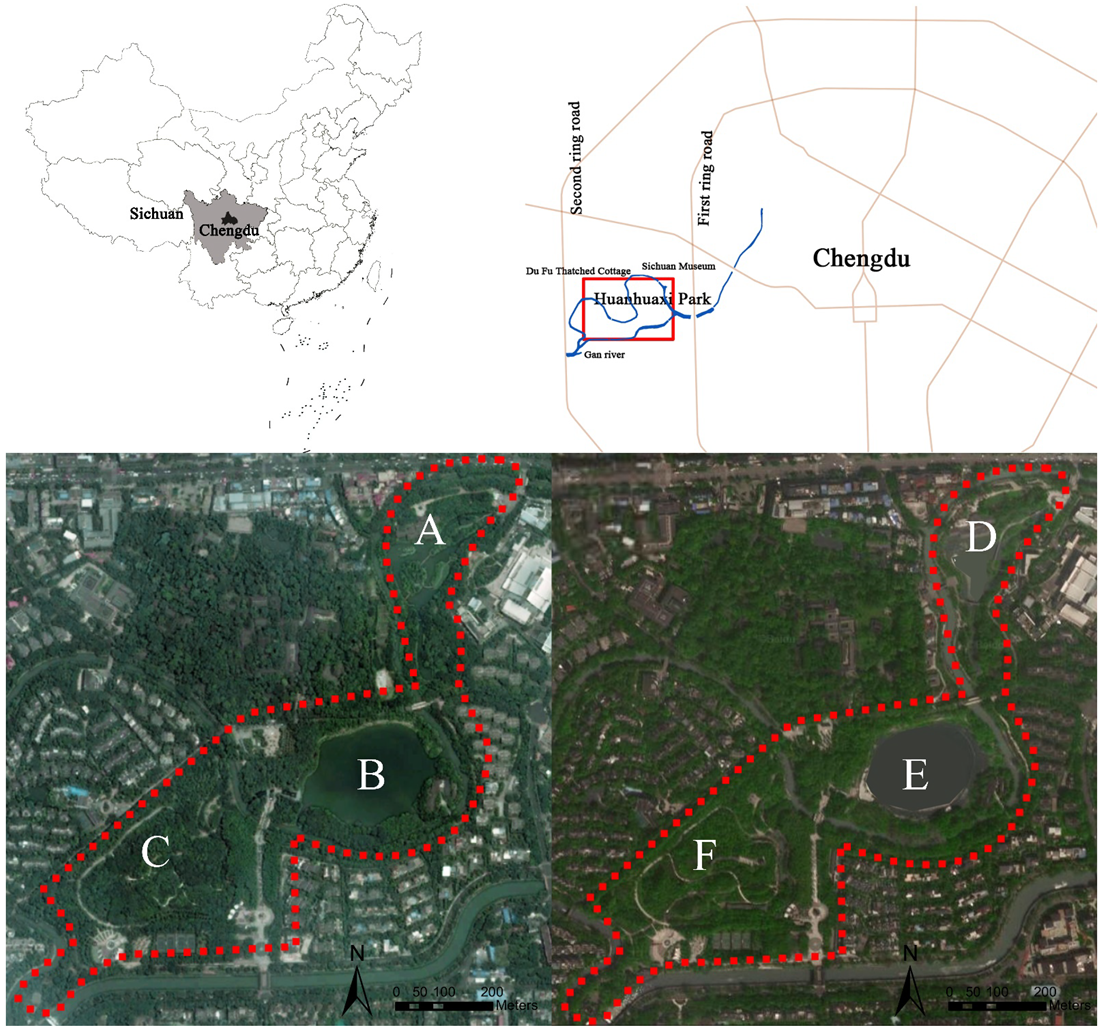

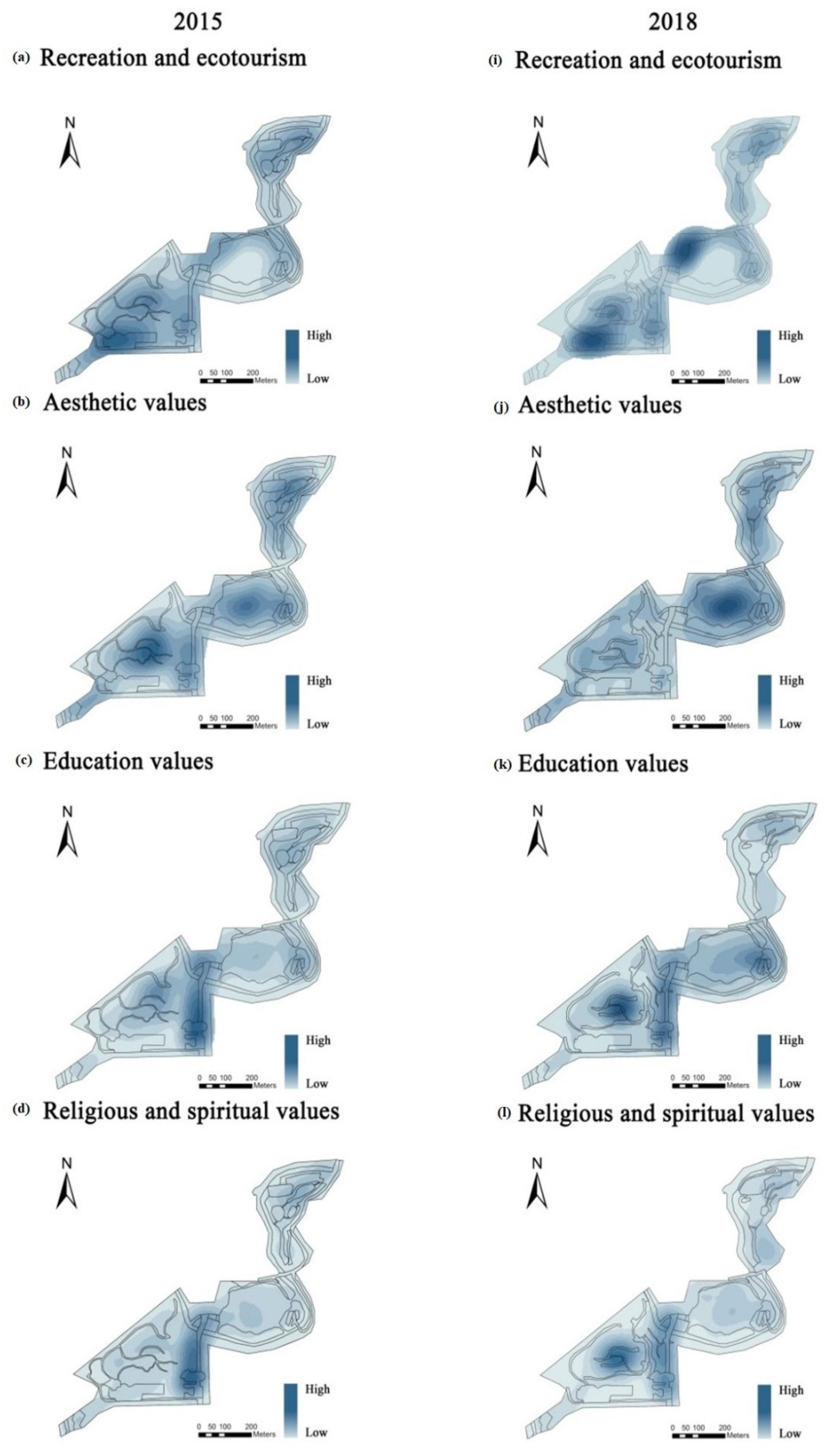
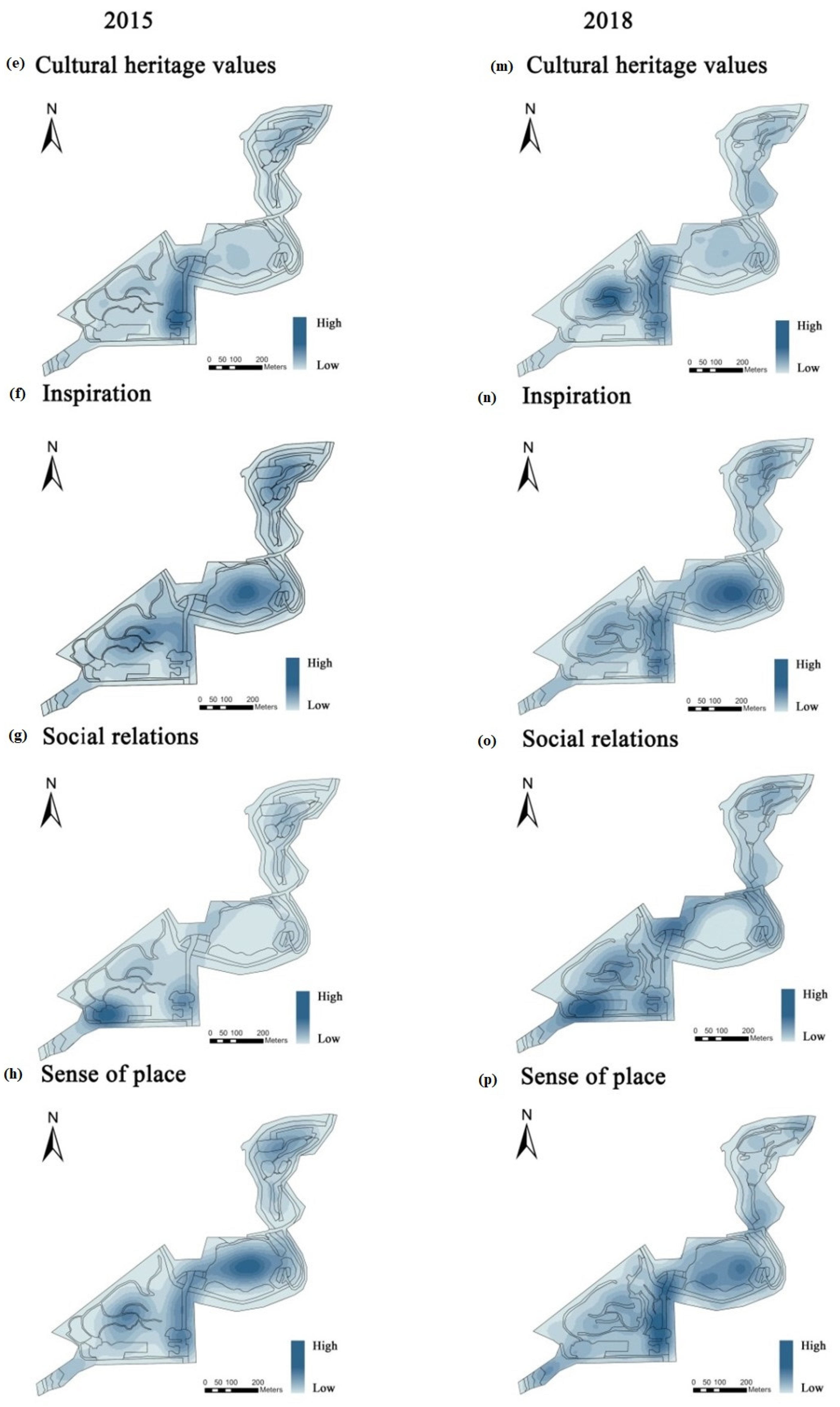
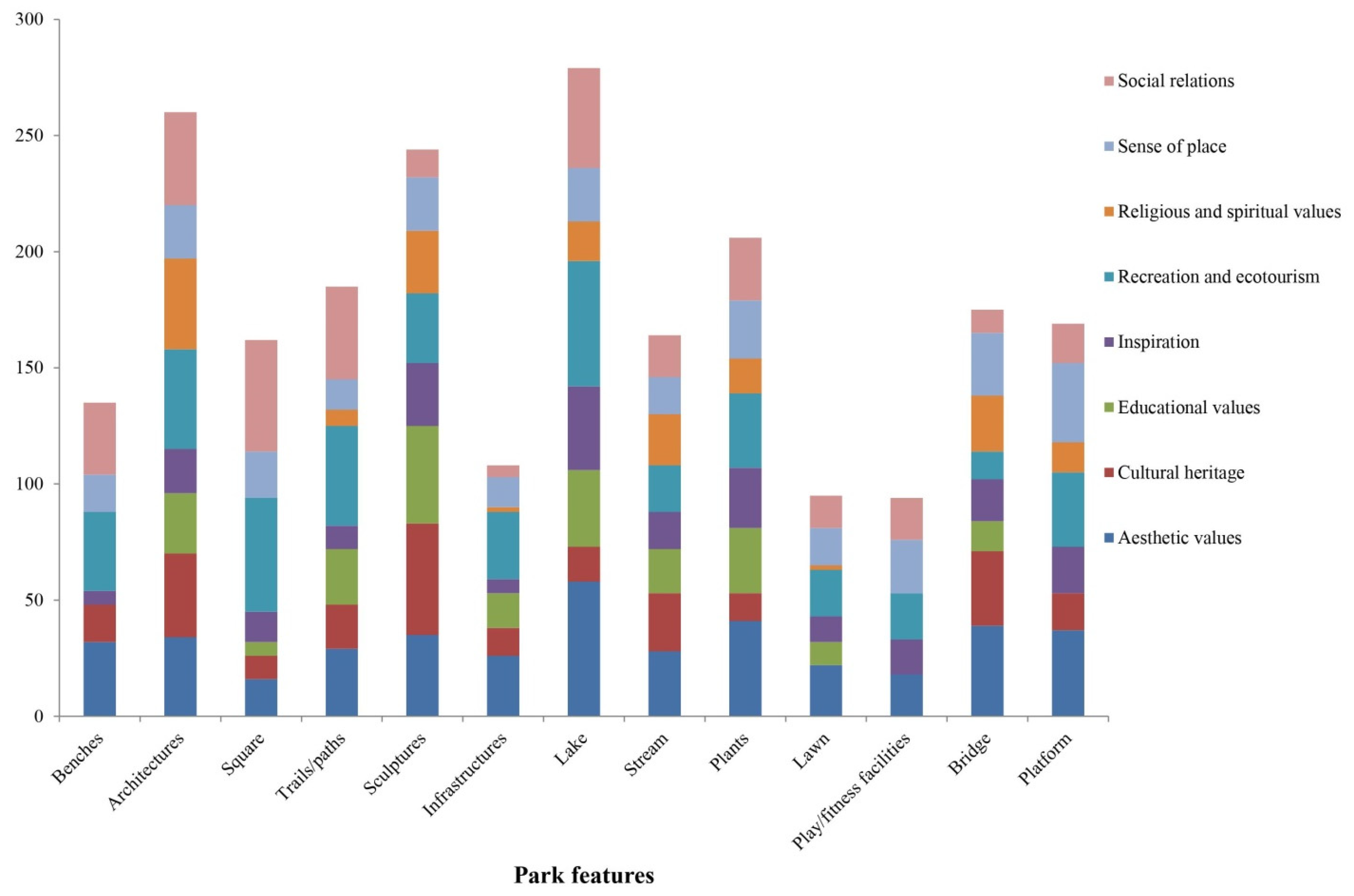
| Locations | Before Renovation | After Renovation | ||
|---|---|---|---|---|
| Canglang Lake |  | Canglang Lake lies in the center of Huanhuaxi Park. It is composed of a square connected to the Thatched Cottage of Du Fu and an island where Huanhua Hall was built. The natural landscape comprises of willows, rockeries, and statues along the bank. |  | The main part of the renovation project was the significant overhaul of Canglang Lake, including the water body, trail, seating areas, sculptures, and plants. Specifically:
|
| Wanshu Hill |  | Wanshu Hill is in the southern part of Huanhuaxi Park. Wanshu means “plenty of plants” in Chinese, referring to the various species of trees growing in this area (especially the bamboo). A pavilion lies at the top of the hill. Several statues are distributed on the hill. |  |
|
| Egret Island |  | Egret Island lies in the north of Huanhuxi Park. The island is mainly covered by wetlands, making it an ideal living environment for egrets. The island is divided into several sections, namely the viewing area, feeding area, and isolation area. The viewing area has a large stretch of high forest, and visitors can stroll by the stream to see the egrets. Wooden bridges connect the islands. |  | The layout of the island was changed.
|
Publisher’s Note: MDPI stays neutral with regard to jurisdictional claims in published maps and institutional affiliations. |
© 2022 by the authors. Licensee MDPI, Basel, Switzerland. This article is an open access article distributed under the terms and conditions of the Creative Commons Attribution (CC BY) license (https://creativecommons.org/licenses/by/4.0/).
Share and Cite
Cheng, X.; Van Damme, S.; Uyttenhove, P. Assessing the Impact of Park Renovations on Cultural Ecosystem Services. Land 2022, 11, 610. https://doi.org/10.3390/land11050610
Cheng X, Van Damme S, Uyttenhove P. Assessing the Impact of Park Renovations on Cultural Ecosystem Services. Land. 2022; 11(5):610. https://doi.org/10.3390/land11050610
Chicago/Turabian StyleCheng, Xin, Sylvie Van Damme, and Pieter Uyttenhove. 2022. "Assessing the Impact of Park Renovations on Cultural Ecosystem Services" Land 11, no. 5: 610. https://doi.org/10.3390/land11050610
APA StyleCheng, X., Van Damme, S., & Uyttenhove, P. (2022). Assessing the Impact of Park Renovations on Cultural Ecosystem Services. Land, 11(5), 610. https://doi.org/10.3390/land11050610






